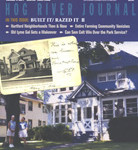(c) Connecticut Explored Inc. Winter 2005/2006
Subscribe/Buy the Issue!
Some themes are so good, they’re worth revisiting. We last explored the built environment and historic preservation in our second issue. In this issue, we revisit the realm of architectural treasures saved, threatened, and demolished—and, in Kevin Murphy’s account of the building of the Barkhamsted Reservoir on page 20, whole communities lost.
You’ll notice our editorial coverage has expanded. With this issue, HRJ is going statewide in order to reach many more subscribers. As a nonprofit venture, we count on your subscription more than most magazines do to continue publishing. In return, we promise you’ll enjoy even more variety—we’ve added eight pages to make room for more stories—even as we continue to explore the history of our capital region.
In the first Built It/Razed It issue (Winter 2003), we wrote of some threatened buildings; now, almost three years later, we wondered what had become of them. Happily, the damage from the SUV that crashed through the front parlor of the Butler-McCook House, the last standing 18th-century residence on Hartford’s Main Street, is a distant memory. The house is back in order after an overwhelming outpouring of community support made possible a complete restoration.
We had also devoted quite a few pages to CIGNA’s corporate headquarters in Bloomfield. Articles explored both then-CEO Frazar Wilde’s vision for putting his headquarters quite literally “out to pasture” in the late 1950s and considered whether a Modernist masterpiece (as some would designate it) threatened with demolition (to make way for condos, hotel and conference center, retail space, and a golf course) could be considered historic and in need of preservation. Since then, much has happened. Foursomes are teeing off on the Arnold Palmer-designed golf course where the distinctive, though quirky, Skidmore, Owings and Merrill-designed 1963 former Emhart Company headquarters stood, but the SOM-designed Wilde Building, which opened to great acclaim in 1957, has been saved, at least for now. Architect Tyler Smith, one of the most vocal advocates for preserving the CIGNA campus, describes the situation as “a glass half full.” While pleased that the Wilde Building is still standing, he laments the “moat of development,” including a luxury apartment complex, that now surrounds it.
In this issue, we are pleased to feature Mary Donohue of the Connecticut Commission on Culture & Tourism’s Historic Preservation and Museums Division and Helen Higgins, president of the Connecticut Trust for Historic Preservation, both of whom offer statewide perspective on the historic preservation movement, past, present, and future. From the shoreline, researcher Liz Farrow describes the restoration of Miss Florence’s turn-of-the-20th-century boarding house for artists, now known as the Florence Griswold Museum.
Trinity College intern Gina Bacchiocchi reacquaints us with two spectacular destinations, in Waterbury and Torrington, from the golden age of theaters. From Litchfield, Rachel Carley relates the story of a church that was jilted at the altar, down on its luck in mid-life, and now getting a well-deserved facelift as the recipient of a Save America’s Treasures grant.
HRJ worked closely with Tomas Nenortas of the Hartford Preservation Alliance and photographer Karen O’Maxfield on a trip down memory lane: a photo essay documenting Hartford neighborhoods past and present. Continue your trip with the second installment of Walter Smith’s Bedford Street Sketches about a boy’s entire world in a few square city blocks in early 1940s Hartford. Last but not least, I defy you to find a more passionate person to write on the future of the Colt Manufacturing complex in Hartford than Bill Hosley.
Welcome to the first issue of the new HOG RIVER JOURNAL, the magazine devoted to exploring Connecticut’s history. It’s still named for and inspired by the little river buried beneath our capital city but now encompasses its journey from headwaters somewhere north of the city on down to the Connecticut River and Long Island Sound—and all points east and west as well.
Explore!
Read all of the stories from the Winter 2005/2006 issue
Read all of our historic preservation stories on our TOPICS page

